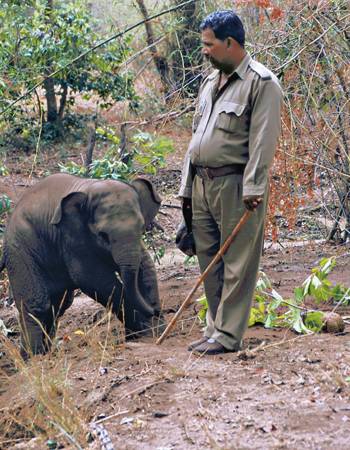E A Kuttappan
Wildlife Service Awards (2007)
The Mahouts of Bandhavgarh, Led By Head Mahout, E.A. Kuttappan
The frontline staff of wildlife reserves – daily wagers, guards, foresters and rangers – are seldom credited for helping protect the forests and wildlife they defend every day of their lives. Most live and die in anonymity. Mahouts, or elephant handlers, are even more invisible. In parks as far removed from each other as Corbett, Kaziranga, Rajaji, or Bandipur, mahouts are the eyes and ears, often the very sinews of the forest department. In Bandhavgarh, the most visible role mahouts play is the carriage of tourists in search of the wildlife they come to see. But the much more important, hidden role is that of anti-poaching, fire fighting and park maintenance. The mahouts work seamlessly with forest guards, rangers and officers, including the Field Director of this incredible tiger reserve.
The relationship between mahouts and elephants is the subject of many books. In days of yore, elephants were captured from the wilds and brutally beaten into submission. Today, with more domestic elephants than wild in India, the recruitment of elephants comes from sources other than the jungle, and the training process is considerably kinder too. The mahout cares for his elephant on a daily basis, feeding, scrubbing, bathing and sometimes just comforting his ‘partner’. Kuttapan, the head mahout of Bandhavgarh, leads a team of dedicated men who unquestioningly carry out any and all tasks allocated to them by the management. He came to Bandhavgarh as a young boy and today at 55, he is probably one of India’s finest tiger trackers, who no longer takes visitors out because the park management has deputed him entirely to anti-poaching and habitat management work. In the tourist season, after a hard day’s work, mahouts often have to do double duty by taking a rested animal out on anti-patrolling, if necessary. This man-animal routine continues uninterrupted throughout the year, even in the monsoon when the park is closed and wildlife is at its most vulnerable.
More than almost any other forest employees, mahouts have the opportunity to observe wildlife in the raw – tigresses with cubs, male tigers clashing for supremacy, new births in the forest, and, of course, the tragedy of deaths they must constantly monitor. In Kuttapan’s case, most such incidents have been recorded on film, making him one of India’s most accomplished wildlife photographers. But he discounts this aspect of his work. In his words: “I am part of a larger team. We are a family and our elephants are our children. We mahouts are the luckiest people on earth because despite the dangers, ours is a job that brings us the respect of the highest in the land. At one time, it was the maharajas who valued us, today Prime Ministers and the rich and famous depend on us to escort them through the forest.”


